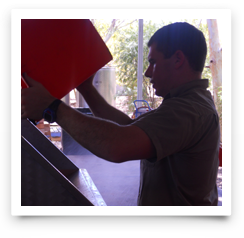 We like to describe our wines as handmade. Hand crafted. As the name Faber suggests – the work of a skilled tradesman.
We like to describe our wines as handmade. Hand crafted. As the name Faber suggests – the work of a skilled tradesman.
But what does this mean, this term that is so often hackneyed and abused?
For us it can be interpreted literally. We planted our vines by hand, trained them, prune them, and pick them – all by hand. We get some help. For example, the Sutherland family has picked our fruit for the last three years. Patriarch Bill – in his sixties, along with daughters Sue, Tracey, Karen, and son Brett can be relied upon to show up on the selected mornings at 5 am and steadily fill the picking tubs until a day’s worth of crushing has been plucked from the vines.
Jane leads the training and pruning of the younger vines. We learnt early on to only allow the vines to stretch just a few inches extra along the trellis wire each year. Any more and the budburst is uneven and the vines set more bunches than they can ripen. If we have too many shoots we thin them out in the weeks after budburst.
John looks after the winemaking. Vintage took four weeks this year – no days off right through February. We have an assistant winemaker Josh – who also brought his own fruit – and an occasional helper in John – who owns the vineyard next door and the “shed”, and we made his wine too.
Before crushing, the white grapes are stacked into the cold room overnight – chilled down below 100C. We tip the crates into the crusher by hand and keep a sharp eye out that the must pump doesn’t block up pumping the crushed grapes. Whites go straight into the press and reds the fermenters. Stalks are pitchforked into the trailer and despatched to the vineyard for mulch. Our open fermenters hold 2 to 3 tonne allowing us to work the cap of skins to exactly control the extraction of colour and tannin. We normally plunge and pump over 4 times a day – splashing, aerating, spraying the sticky purple juice around – starting first thing and with the last pump over before hitting the sack about midnight. This is when we really taste the wine – does it have enough tannin, is the colour dark enough, what are the fruit flavours, should it be warmer/colder? There is no substitute for running it over your hands and smelling the vapours given off by the ferment.
We have to shovel the marc out of the fermenters into the press. We take off our boots and socks and jump in – it normally comes up to your thighs. Our press is an airbag type. We inflate the bag until the juice begins to flow out. We constantly taste the juice as the amount of pressure applied influences the degree of tannin extracted. The best white juice is the free run – relying on gravity pressure alone. We switch to pressings at the first hint of tannin and loss of fresh fruity aromas. The best red wine is that extracted with the application of low pressure. We find this has the perfect balance of tannin and fruit. We separate 3 or 4 different fractions, with the best used for our Reserve – in the case of shiraz. The pressed skins are dumped out and shoveled onto the trailer.
The white juice is settled and racked off lees before fermentation. We add rehydrated yeast and taste the ferment and measure the change in sugar at least 3 times daily – each time adjusting the ferment temperature to control the rate of ferment. This is crucial as it influences the flavours produced by the yeast and the amount of residual sweetness in the wine.
After ferment reds are filled into barrel and whites are chilled and filtered ready for bottling. We usually filter the whites once and then we take them in tanks on the back of our ute to a neighbouring winery for bottling. It’s a pretty low-tech process but the wines are well protected from air contact. We put the caps on by hand and pack the bottles into boxes, and stack them.
All of our red wine is stored in oak. We taste them every month or so and top up the amount that has evaporated. After malolactic fermentation and again after winter we rack them out of oak, and then refill them. This exposes the wines to air, which assists their maturation, and also improves their clarity. The barrels are called hogsheads and hold 300 litres each. They weigh about 75 kilos each and we manhandle them around, washing them out and restacking them.
We usually filter the red wines once and hand bottle them ourselves. We don’t filter the Reserve as it has had nearly two years in oak and is very clear. Our bottling line is very simple – one person puts the bottles on and off, one corks, and one stacks. Occasionally we forget the pump and the little filler overflows and sprays everyone with wine. Jane does the job of labelling, capping and boxing of the wines just before they are released.
So we think you would agree that our wines are truly handmade!
